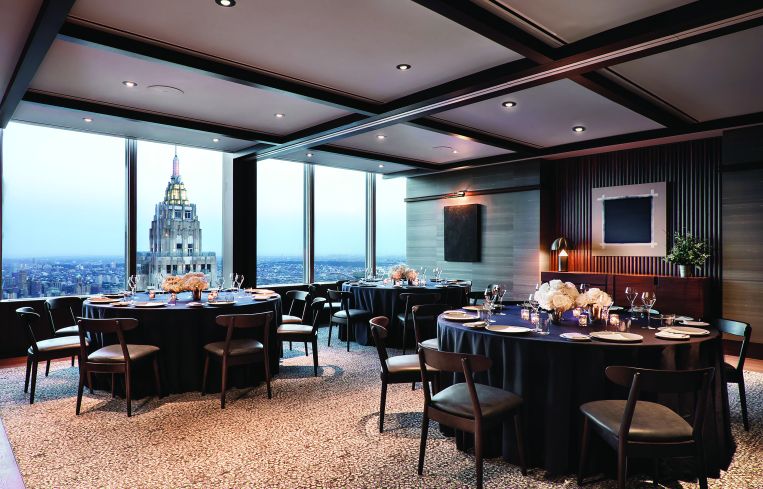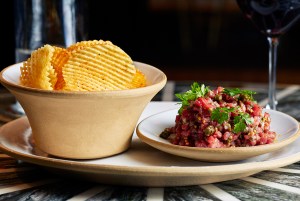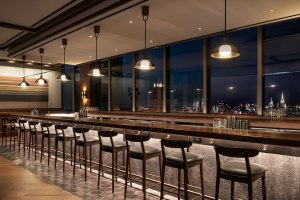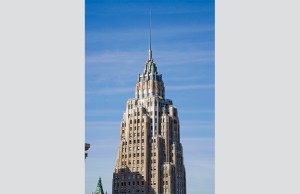FiDine: Inside Lower Manhattan’s Burgeoning Restaurant Scene
Can Lower Manhattan really turn into a fine dining destination? Too late—it already has!
By Sara Pepitone October 16, 2018 10:15 am
reprints
Fine dining, Financial District: Two things you never expected to find in the same sentence. Yet here we are, looking down on the city’s oldest neighborhood, today bounded by City Hall and the Battery, from the East River to Broadway, jostling tourists and foodies for a view of it all from the 60th floor of 28 Liberty on a Saturday night.
In case you missed it, the top floor at 28 Liberty Street, David Rockefeller’s 1961 rectilinear aluminum and glass tower, formerly called One Chase Manhattan Plaza, is now home to one of the hottest restaurants in New York: Danny Meyer’s Manhatta, where you’ll find a French-inspired, three-course dinner for $78, tip included.
Manhatta shares its 38,000-square-foot floor with a private event space and is a partnership between Fosun International and Meyer’s Union Square Hospitality Group. According to a USHG spokesperson, “primetime reservations tend to fill up 28 days in advance.” Including weekends. (Fosun did not respond to a request for a comment and Meyer was unavailable.)
To best appreciate this phenomenon, consider the evolution of both fine dining and the Financial District. The former used to mean white tablecloths, special occasions and suits. Today a fine dining restaurant is, simply, one using the highest-quality ingredients, served by people who can speak to them. The latter used to mean financial services, market hours and suits. As Eric Bromberg, a co-founder of Blue Ribbon Restaurants, put it, the Financial District “was a just a maze of barren corridors after 6 p.m. It just kinda turned off.” Today, as has been widely reported, the neighborhood is lively at all hours, and referring to it as the Financial District is pretty much as reasonable as calling it the nation’s capital. That was 1789-90.
“FiDi is probably one of the most under-appreciated food neighborhoods in the city. When the opportunity arose to open down here, I jumped,” said Derek Feldman, the founder of Don Wagyu at 28 South William Street, where the ingredient, specifically Japanese beef (wagyu), is king. Opened in June, this restaurant serves only wagyu steak sandwiches—three of them—the most talked about being the $180 Ozaki, which is made with the highest grade wagyu, sourced from a farm in Japan. At 11:00 a.m., opening time on a recent Saturday, there were already four diners inside: A chic couple, he with British accent, and a man on a business call, speaking Spanish, his teenage son beside him. (There are only six seats in the whole place!)

This is fine dining in 2018. And everyone credits restaurateur Keith McNally and chef Tom Colicchio with bringing it to FiDi with Augustine and Temple Court, respectively. (Long before them there was Delmonico’s, celebrating its 181st anniversary with an asterisk—i.e., changes in ownership and location, plus some years closed.)
McNally’s Augustine, a brasserie like Balthazar, and Colicchio’s Temple Court (née Fowler & Wells, renamed last summer) opened in adjacent ground-floor spaces at 5 Beekman Street (a.k.a. The Beekman hotel) in August 2016.
“If anyone else does this I am going to be really jealous,” Colicchio said to himself the first time he saw the space, then only cement floors and walls dripping water, the cast-iron balconies and skylight of the nine-story atrium not yet restored (if you have not been, go now, it’s stunning, and more so with a cocktail and something to eat). Back then, he figured it would be busy with bankers. He was right about the busy—breakfast, brunch, lunch, dinner, dessert, coffee, cocktails, room service, events—and wrong about the bankers; creative people and residents fill the seats. “I was surprised by how many people live Downtown,” said the Brooklynite, now fully appreciating the convenience of the neighborhood’s many subways.
He’s in a long-term lease, paying a base rent and a percentage of sales, a deal that began when landlord Allen Gross, the chairman and CEO of GFI Capital, contacted him through his cousin Phil Colicchio, a food hall developer and consultant.
In March 2017, Bromberg and his brother, Bruce, opened Blue Ribbon Federal Grill on the ground floor of AKA Wall Street, a hotel at 84 William Street. They first saw the 4,024-square-foot space, including an 800-square-foot cellar, in early 2016 when, Bruce said, “There was an early excitement for the culinary future of the Financial District.”
Many of the high-profile restaurant players started announcing and opening at that time, noted Jessica Lappin, the president of the Downtown Alliance, which manages the Lower Manhattan Business Improvement District (the Financial District plus the blocks to West Street).
However, in 2012, (said Marc Ehrlich, laughing in recollection), the neighborhood’s dining options were “limited.” That’s the year the CIO of Rose Associates began the adaptive reuse of the 1-million-square-foot 70 Pine Street. “Capital Grille had the market for business-related meals,” he said. (The Capital Grille outpost, at 120 Broadway, opened in 2009).
But it’s no surprise to Ehrlich that the dining landscape has drastically changed. And it’s not just because of the evolving palates and expectations of technology, advertising, media and information services, or TAMI, tenants coming in to replace financial services, he said. “Look at where the Financial District sits: in between Manhattan and Brooklyn residential corridors. From a dining perspective, it’s convenient. It’s an easy place to meet up. And it has unprecedented subway access.”

Today, Ehrlich, who oversees joint ventures and financing for the firm’s investments and developments, is planning two restaurants for 70 Pine, both to open in the first quarter of 2019. One, more casual, will be at its base. The other aims to capture the fine-dining crowd. In partnership with chef James Kent, Ehrlich said, they’re creating “a great dining venue and great experience that’s open to the public and is an amenity to tenants.”
Ehrlich and his team sought out chefs of Kent’s pedigree (from line cook to chef de cuisine of Eleven Madison Park, then executive chef of NoMad) to fill 76,000 interior square feet and 3,500 exterior square feet over floors 62 to 66. Yes, that means a multi-level venue with bird’s-eye views and outdoor seating. Ehrlich would not divulge terms, but admitted he’s planned a long-term relationship.
The neighborhood’s evolution as a dining destination is perhaps best illustrated by the growth of the Alliance’s Dine Around Downtown event. Launched in 1997 “with just a handful of willing restaurants in an effort to educate the local workers on where they could go to eat,” this year there were some 50 restaurants and more than 15,000 attendees, according to Lappin.
“It’s emblematic of the renaissance of Lower Manhattan,” Lappin said. “The diversity and rapid growth of our dining scene really reflects the people. Over the past 20 years, our residential population has tripled, with 60 percent identifying as young professionals. And just this year we reached our highest employment levels since September 11th [2001], with a private sector workforce of 242,000 people that skews toward creative, ad, media and tech industries.”
According to the Alliance, in 2017 more than 60 bars and restaurants opened in Lower Manhattan, with weekend service at nearly 90 percent of them. That includes Nobu Downtown, which moved to 195 Broadway from Tribeca, and Kesté Pizza & Vino at 77 Fulton Street, the second location of the Neopolitan pizza mecca-plus-school, run by Roberto Caporuscio, the president of an Italian governing body that certifies pizzaiolas. Not your $1 pizza joint.

In August, the Alliance reported that neighborhood commercial leasing activity reached its highest level since second-quarter 2011, with 1.9 million square feet of new leases.
That report included the 60-seat, approximately 1,000-square-foot restautant Bellini on the ground floor of boutique hotel Mr. C Seaport at 33 Peck Slip, both by Cipriani and which opened in August of this year.
“As development continues within the [South Street] Seaport, both residential and commercial, there is a growing need for more diverse dining options,” said Ignazio Cipriani, who opened the luxurious (white tablecloths and rose seat cushions) high-end restaurant to cater to hotel guests and locals. “We wanted a place that was at the same time elegant, but relaxed and welcoming.” So far, he said, it’s been a hit.
That makes sense to Alex Cohen, a salesperson with Compass. He’s worked in the neighborhood for 20 years, including helping tenants displaced by the Sept. 11 attacks. No one talks about this part of town without reflecting on that day and its impact. After, Cohen noted, many older, smaller, inefficient buildings were converted to residences, starting a trend that’s now a few years into new builds.
“The influx of new-construction apartments and the repositioning of the seaport have changed the profile of tenants to reflect a residential neighborhood,” said Cohen, citing fashion, jewelry, yoga, art studios for kids and blow-dry bars. If you just popped someone in to Bellini or 10 Corso Como they wouldn’t know what neighborhood they were in, he said, recalling a recent night. “You could have been on East 53rd Street and seen the same clientele.”

Cohen is marketing 850 square feet at 211 Front Street, a.k.a. 142 Beekman Street. The brochure lists Jean-Georges Fish Market as coming, and notes the potential for an outdoor café. Asking rent for the corner location is $150 per square foot.
Up the street, at 45 Beekman Street, Michelin-starred chef Massimo Sola is part of the team behind Sola Pasta LAB, expected to open this fall. It’s a satellite of Sola Pasta Bar at 330 West Broadway in Soho, where diners make their own pasta. Asking rent for the 3,700 square feet, including the 1,500-square-foot basement, was $47 per square foot, or $22,500 per month. Josh Singer, a vice president at the Heller Organization, represented the landlord in the transaction. He’s been representing and leasing space in the neighborhood for 12 years now; his portfolio currently includes 60 Fulton Street and 40 Gold Street. He expects fast-casual concepts with high-end ingredients, which he calls “the new wave of fast food” (see Don Wagyu, above) to take the spaces. “FiDi is a great market for fine dining as there is a large office population in place that needs options in which to entertain and meet with clients. Additionally, the residential population has steadily increased.”
Singer noted that retail rents in general are down about 20 percent in FiDi since 2015. “That said,” he added, “certain submarkets are better insulated against rent elasticity than others. I’d say FiDi is one of those markets, as there are institutions in place—Wall Street, the 9/11 Memorial and Museum, Fulton Street Transit Hub, NewYork-Presbyterian/Lower Manhattan Hospital, Pier 17 and others that will guarantee a certain level of foot traffic and demand.”
That’s what attracted Dana Bloom, whose San Francisco-based Proper Food opened its first New York City outpost at 67 Wall Street near the end of September, joining Sweetgreen, Joe and the Juice and La Colombe.
“FiDi is an ideal location since it has a high number of large businesses and business professionals in a concentrated area. Our customer is one who is crunched on time, but also wants to eat well,” said Bloom, noting the popular PB&J, with house-made coconut peanut butter and jam for $6.95. Proper Food is in a long-term lease brokered by Robert Bonicoro of CBRE and Robert K. Futterman of RKF. Neither responded to requests for comment.
Of course, the restaurant business is not an easy one; 17 percent of restaurants fail in their first year according to research by University of California Berkeley’s Philip B. Stark and the U.S. Department of Labor’s Tian Luo.
Harry & Ida’s Luncheonette, a high-end Jewish deli run by siblings Will and Julie Horowitz, opened in September 2017 at 11 Park Place, and closed in less than a year. Will Horowitz did not respond to a request for comment.
Bruce Bromberg summed up the Financial District like this, “While there’s still a way to go, there’s a deep level of positivity and growth in the neighborhood with some of the best chefs in the world opening and operating just a few blocks away.”
Next up, at Pier 17, is an 11,000-square-foot “Italian chophouse” by Andrew Carmellini, and a 50,000-square-foot food hall and 7,300-square-foot seafood restaurant by Jean-Georges Vongerichten. Fine dining indeed. Plus river views. Financial District destination dining has arrived.



